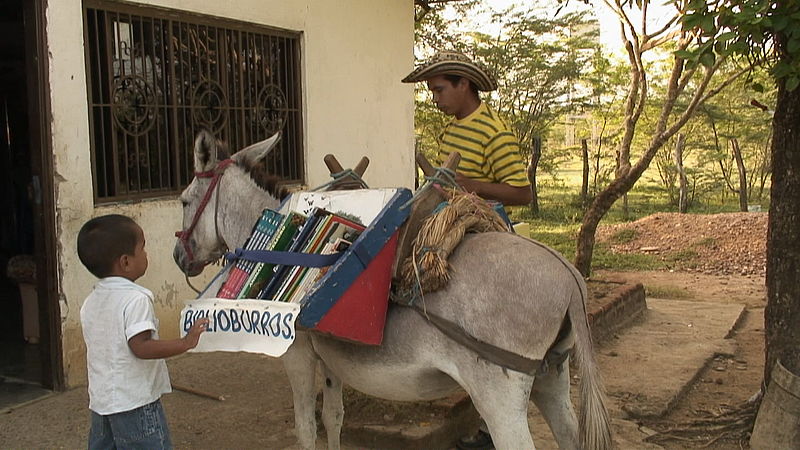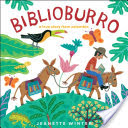Reviewed by Katie Seitz
Review Source: Teaching for Change
Book Author: Jeanette Winter
In Colombia, internal conflict between paramilitaries and guerrilla groups ebbs and flows, exacerbated by political upheaval and the drug trade. In the north of Colombia, in a rural area controlled mainly by paramilitaries, and still under threat of violence and repression, a former schoolteacher has outfitted his burros as a mobile lending library. For 10 years, Luis Humberto Soriano Bohórquez has gone from village to village reading to children, helping them with their homework, and lending books to anyone within burro distance. He and his wife have also built a library that serves more than 250 children in the area.

In the course of his travels he has been threatened with violence, has been robbed, and has injured himself in a fall from his burro. Despite these obstacles, he continues to promote literacy because he believes that it is key to ending violence and bringing peace to his country. Soriano Bohórquez’s courageous work is the inspiration for two recent children’s picture books, both published in English in the United States.
Waiting for the Biblioburro, by Monica Brown, tells the story through the eyes of a little girl named Ana, whose town receives a visit from the Biblioburro. See review.
Biblioburro: A True Story from Colombia, by Jeanette Winter, follows Soriano Bohórquez through a day of trekking into the countryside and back with his library. Reviewed below.
Both books simplify Soriano Bohórquez’s life and mission, as one would expect, but a closer examination of each text shows the troubling degree to which essential details have been purged and sanitized for a U.S. audience.
Biblioburro: A True Story from Colombia takes a more accurate approach to the story of Soriano Bohórquez, according him a first name and the story a location. The story introduces Luis, who likes to read. He acquires too many books, and his wife, Diana, complains. He gets the idea to share his books with children, and loads up his burros with books. On his way to a village, he meets a bandit, who steals one of his books. He reaches the village and reads a book about pigs to the children, then returns home to eat dinner and read late into the night.
The book matter-of-factly depicts the amount of work and danger that the bibliotecario faces each day that he sets out on his rounds, rather than presenting him as a Johnny Appleseed-style figure that simply appears when he is most needed. However, it still leaves out wider political context, recasting a real-life incident in which Soriano Bohórquez was accosted by a group of paramilitaries as an encounter with a single “bandit.”
The book has other significant missteps. Winter’s illustrations, while beautiful, present Colombia as a cartoon jungle full of oversized animals and few, if any, houses, contributing to the U.S. stereotype of foreign countries (especially those in the Global South) as exotic and backwards.
Winter also decides to portray Diana, Soriano Bohórquez’s wife, as a shrew and a drudge. In the book, her irritation at the growing piles of books induces Soriano Bohórquez to think of the Biblioburro. She packs his books onto the burros and, when he returns, cooks him dinner. The few actions allowed her make her seem entirely adjunct to her husband.
In reality, Diana also helped to build the library, making it unlikely that she would berate her husband for collecting books. In addition, the couple runs a small restaurant to make their living, which means that she would have little time to assist him in his daily routine.
Both Biblioburro: A True Story from Colombia and Waiting for the Biblioburro, in the opinion of this reviewer, manifestly underestimate children’s ability to accept what is real.
Children encounter trauma, poverty, and loss every day, and see it in the lives of others. There is no reason to traumatize children through their reading.
But going to the opposite extreme and removing any signs of struggle from their books, defeats the purpose of telling real stories at all.
By the same token, allowing exoticization and stereotyping of other people and countries also serves to diminish the benefit of telling children stories of courage and change.
Let us write and buy children’s books that respect both the subjects of the stories and the children we are hoping to enrich.


Biblioburro: A True Story from Colombia by Jeanette Winter
Published by Simon and Schuster on June 28th 2011
Pages: 32
ISBN: 9781442440739
Buy at Powell's Books
SYNOPSIS: A man, his burros, and his books bring joy to children in remote Colombian villages in this inspiring book based on a true story.

Leave a Reply